Short S45A Solent Mk.IV
Background
The Solent was a development of the Short S.45 Seaford, which was in turn a development of the Sunderland ( and originally designated Sunderland IV). The first aircraft produced was a civilianised Seaford, and after trials, 12 aircraft were ordered for BOAC service. These Solent II's carried a crew of seven and 30 passengers. In 1948 six unfinished Seafords were completed as Solent III's, capable of carring 39 passengers. In 1949 TEAL ordered four of what would be the final model, the 44 passenger Solent IV. This featured a number of changes to meet TEAL specifications, including the 2040 hp Bristol Hercules 733 engines (compared to the 1690 hp Hercules 733) on improved mounts which made the engine thrust line parallel to the airframe centreline (rather than splayed outward 3 degrees as on the earlier models), a maximum all up weight of 36,742kg (81,000lb) compared to the 35,643 (78,600lb) Solent III, and a range of 3745km. Two and a half years after the BOAC Solents entered service, BOAC ended all its Flying Boat operations and the aircraft went into storage. One of these Solent III's was purchased by TEAL in 1951 as Solent production had ended.
The Solent was the final flying boat type operated by TEAL, an airline best remembered for such services. In 1935 the Chairman of the Union Steamship Company Ltd (Norrie Falla) had raised the possibility of a Trans-Tasman airlink with Imperial Airways services. In 1937, after protracted discussions, the Short S23 Empire Class flying boat 'Centaurus' (G-ADUT) was used to prove the route, arriving in Auckland on December 27th. Subsequently Tasman Empire Airways Ltd (TEAL) was formed with a shareholding split between the New Zealand Government, Union Airways, Imperial Airways and QANTAS (the three airlines effectively operating TEAL for their respective governments). An order of three S30 flying boats (a development of the S23 with Bristol Perseus XIIc engines, a 2400km range and higher all up weight) for QANTAS was diverted to TEAL - although only two were eventually delivered, the third being diverted for wartime services with Imperial Airways and BOAC. The two aircraft ZK-AMA (c/n S886) 'Aoteoroa' and ZK-AMC (c/n S884) 'Awarua' went into service in 1940 and flew Tasman and Pacific routes until 1947. In 1946 the decision was taken to replace the S30's with Sandringhams IV's (a civil modification of the Sunderland III). The decision was a political one, overiding a preference amongst TEAL's senior personnel for land-based DC-4's. The 'Tasman Class' Sandringhams (ZK-AMB/ML761 'Tasman', ZK-AMD/NJ255 'Australia', ZK-AME/NJ719 'New Zealand', and ZK-AMH/JM715 'Auckland') only remained in service until 1949, proving to be underpowered and prone to overheating in the trans-Tasman environment. They were replaced in 1949 by the Short Solent IV. Again the decision had political overtones as TEAL's senior personnel still preferred land-based DC-4's or DC-6's.
TEAL's trans-Tasman Solent services commenced in November 1949, beginning with Auckland-Sydney and then Wellington-Sydney in 1950. The RNZAF Sunderland services to Fiji were also taken over by TEAL, as well as services to the Chatham Islands. In December 1951 the Coral route was established - this was primarily a mail service, but provided one of the last 'luxury' tourist routes. The journey harked back to the 1930's with the twin deck flying boat carrying a relatively small number of passengers. Initially a monthly service, the journeys were made fortnightly in 1952, and the route extended to include Samoa. The route and typical flying times were: Auckland - (7.30hrs) - Fiji - (3.45hrs) - Samoa - (5.00hrs) - Cook Islands - ( 4.05hrs) - Tahiti. I have seen the old flying boat base at Aitutaki, in the Cook Islands. One can appreciate what it must have been like, as today's air link from Rarotonga flys in over the lagoon and its surrounding islets. One can also appreciate the 1.7m (5'7) draught of the flying boat when looking at the coral heads while travelling across the lagoon by regular boat! These had been cleared by the route proving team operating from Catalina ZK-AMP. In March 1954 three DC-6's were transferred to TEAL after the winding up of British Commonwealth Pacific Airways. This sounded the finale for the trans-Tasman flying boat services as the Solents were replaced on the Tasman and Fiji routes. One Solent IV, ZK-AMO was retained for the Coral route and the Solent III ZK_AMQ provided a reserve. The final flight from Fiji occurred on September 15th, 1960. After due ceremony, the aircraft departed from the flying boat base at Lauthala Bay carrying somewhat modified markings to return to Mechanics Bay in Auckland. From there it was towed to Hobsonville for storage before being beached for display at MOTAT.
The other TEAL Solent IVs were ZK-AML 'Aoteoroa II' (c/n SH-1556), ZK-AMM 'Ararangi' (c/n SH-1557), and ZK-AMN 'Awatere' (c/n SH-1558). The sole Solent III was ZK-AMQ 'Aparima (c/n S-1296) which was originally G-AKNR 'City of Belfast' with BOAC. AMQ was scrapped at Auckland in 1957 after making its last flight in October 1956. AMM was broken up for spares after being damaged in a fire during maintainance in May 1954. AML and AMN were sold to Aquila Airways - an English company formed to provide air support during the Berlin Airlift in 1948 which went on to fly from Southampton to various Mediterranean destinations. Unfortunately the company failed in 1958 and the flying boats were left to become derelict on a beach in the Tagus Estuary near Lisbon, Portugal. They were eventually scrapped in August 1971.
The aircraft illustrated below, ZK-AMO 'Aranui' (c/n SH-1559) is the world's sole surviving Solent IV. (although there are also several Solent III's in existence). Built by Short Bros & Harland of Belfast, the aircraft was delivered in November 1949. As noted above, after entering service in December 1949 Aranui remained in operation until 1960, flying the 'coral' route. This is the last purpose built large commercial flying boat, and as such has an important place in aviation history. Unfortunately the aircraft sat outside for a number of years, exposed to weather and vandals. However in the mid-80's serious restoration began.
Restoration is being carried out by the Solent Preservation Society Inc. under the auspices of MoTaT. The Society grew out of the Friends of the Flying Boat, a group of ex-TEAL employees which flowed on from the '20 Year' Club who were interested in maintaining contact with former co-workers. The Solent provided a focus for their activities. Because of the need to raise money to begin serious restoration, a meeting was held in 1983 at Ellerslie to create a registered Incorporated Society. This enabled the group to apply for funding from 'official' sources, such as the lottery board. The first President of the Society was Joe Shephard, and following his death in 1987, Ray Gasparich (the first vice-President) has been President. The Society has two official meetings a year - an annual general meeting, and a more social meeting with a guest speaker (generally associated with the aviation industry).
The activities of the 'Friends of the Flying Boat' started around 1982 with corrosion control and repairs. The restoration began with slow improvements to the aircrafts interior - the relining and repainting of the passenger cabins, and the refurbishment of seating. Various small groups worked on projects in different parts of the aircraft. In 1989 the Solent was moved into MOTAT's new purpose built display hangar, and a more serious phase in the restoration began. The exterior of the aircraft has been cleaned and painted in TEAL plumage. Inside the refurbishment is nearly complete, and apart from fine details the restoration is nearly done on an aircraft now serves as a fine memorial to its part in aviation history. Ray tells me that funds in the order of NZ$80,000 have been spent, and this struck me as a remarkably small cost. However, he also explained that the Society had 'not expected anything for nothing' but that many items had been supplied at cost price or less. Many of the sponsors are listed on boards displayed with the aircraft.
Working sessions are held on Wednesday morning at the Solent, in MOTAT's Aviation Section. The Society utilises a cooperative working setup - with the committee leading from the front. Work required is identified, and those who wish to participate do so. Although the restoration is nearly done, an aircraft like this requires ongoing maintenance. The society membership which once reached nearly 200 has been reduced by attrition to about160, but the group is positive and attendance is strong. Some new aviation minded members have appeared, but the Society would welcome new members with an interest in aviation, and a willingness to assist in the continued existence of the Solent.
As a final note, one other ex-TEAL Flying Boat survives. The Sandringham IV 'Tasman Class' flying boat ZK-AMH resides at the Hall of Aviation museum in Southampton.
Last Update:- 29 September, 1998
Special Feature: A Virtual Tour inside the Last Solent IV!
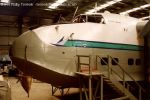
|
On December 10th, 1997 I arranged to meet with Phil Furner, my Lancaster contact at MoTaT. He organised tours for me of several other aircraft at MOTAT - one of which was the Solent. I have looked through the windows of this aircraft on a number of occasions, so it was exciting to finally get inside! I was introduced by Phil to several of the folk involved with the Solent restoration - in particular my guide for the tour, Ed Tredrea, who it transpires became a Solent Captain in 1952. He had much to tell me about the aircraft and its operations. I visited the aircraft again on January 21st to repeat some of my photographs with a 28mm lens (the 35mm just wasn't wide enough), and to confirm some of the details with Ed. Then I also had a chance to chat with Solent Preservation Society President, Ray Gasparich. What follows is an account of my first visit - with photographs from both visits
|
|
We (Ed and I) entered the aircraft via the crew entrance in the nose on the port side (shown above). This gives access via the No.1 hold to Cabin A and Cabin B. There are five cabins on the lower deck, along with the toilet compartment and 2 holds.
The picture to the right shows the hold, the access hatch being on the left, and the access to the bow is forward. Original equipment remains, like the sea anchor drogue.
|
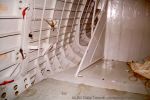
|
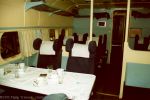 Cabin A - looking aft
Cabin A - looking aft
|
Cabin A is set up with six seats arranged four to starboard and 2 to port, with tables. I wasn't able to sit down, but the seats are high backed with headrests, and appear very comfortable. There's also lots of leg room! Aft of Cabin A is Cabin B - this is currently set up with six seats, in a more typically modern arrangement - and would look even more modern with its full quota of nine seats.
|
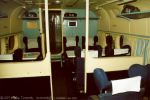 Cabin B - looking forward
Cabin B - looking forward
|
|
Moving aft is the 'toilet' compartment - two to starboard and one to port. The port facilities are the 'Ladies 'Powder Room' featuring more space, a table and mirror. (Unfortunately I couldn't do it justice with the camera). In the central passageway of the compartment is a ladder leading up to the flight deck. This actually emerges between the wing spars (more on this later). The hatch can be seen in the ceiling.
By now you will have noticed the trendy blue and beige paint scheme, with the dark blue seats - it doesn't do a lot for me (but then most airline colour schemes don't), but it was very fashionable for its time. Some of the aircraft also featured murals!
|
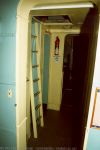
|
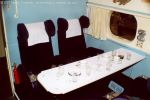
Left: Cabin C - port side
Right: Looking aft to the stairs
|
Next is Cabin C, another six seats arranged four to starboard and 2 to port, with tables. Immediately aft of this cabin is the stairway on the starboard side. I found it a surprisingly large staircase - not huge, but not as cramped as I had anticipated. This really was a luxury way to travel. Opposite the stairway on the port side was a 'dumbwaiter' from the galley above. Ed explained to me that the crews found this did not work terribly well, and they preferred to simply carry food down the stairs - so this space eventually become a coat cupboard.
|

|
|
Beyond this is Cabin D - only four seats, two on each side with tables. The aircraft is displayed with a medical stretcher set up on the port side. This shows how patients were carried from the Pacific Islands to Auckland for treatment. The patient had a curtain for privacy. On the starboard side a baby's crib is set up. There was no seperation by 'class' on the TEAL flights, seating was arranged at boarding - and there wasn't a 'no-smoking' area. But Ed told me that Cabin D was often used for families - with the space in Cabin E, children had a little room to keep occupied.
|
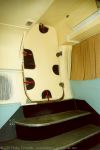
|
The aft cabin 'E' is the passenger entrance. A hatch with stairs down is on the port side. On the starboard side is a couch, which also served as three seats if required for passengers. Aft of this is the number two hold. As can be seen in the picture, this area is still used today for storage. This lower area of the hold shows the construction of the aircraft back to the rear of the keel. More on the upper part of the hold later.
Left: Passenger entrance
Right: Hold Two (lower)
|
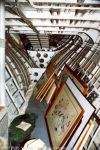
|
|
Left: Cabin F - looking aft
Right: Cabin F - upper deck looking forward
|
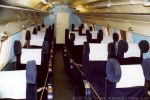
|
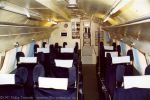
|
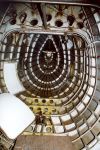
Hold Two -
upper level
|
Ed and I then made our way forward to the stairway, and ascended to the upper deck. At the top of the stairway is a noticeboard with a current position chart still displayed. This would be updated regularly during the journey. The image below also shows the skylight which doubled as an escape hatch, and the ladder for emergency egress.
The upper cabin occupies the rear half of the aircraft and seats 16 passengers. At the rear of the cabin is the access to the upper part of the No.2 hold. This is also being used for storage - looking like a wardrobe with a range of TEAL uniforms. Beyond these, as the photo shows, you can again get a look at the aircraft construction. Ed pointed out that due to the original anodising treatment of the metal (planned for operation in a marine environment), there is very little corrosion to be found.
|

Cabin F -
top of stairwell
|
|
Again we made our way forward - past the ladder at the top of the stairs leading to the escape hatch in the roof - and into the galley. This is quite spacious - particularly compared to some of the modern airliner galleys I've seen. (I've seen apartments with smaller kitchens than this). In the view below, you can see the oven and hotplates on the port side. The hole in the forward bulkhead is a crawlspace forward to the flightdeck. Above the cooking area a window can be seen (there are two on the port side - one to starboard). The fan wasn't standard equipment.
|
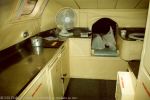
Galley - looking forward.
|
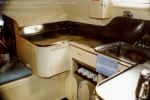
Galley - sink area.
|

Galley - looking aft.
|
On the starboard side are a sink and benchspace. Various recesses hold crockery and implements - some of which (cups and plates) can be seen under the sink. Many original items are on display - a jug is partially obscured in the corner of the picture. The view on the right is looking aft from the crawlspace. On the bulkhead above the sink is the PA and intercom. Two of the windows can be seen. The galley seems quite light and spacious - if the roof wasn't curved it could easily be mistaken for part of a small apartment. The galley door is at the far end turning right.
The cooking was carried out on board by a Steward (each flight carried two Stewards and a Stewardess). Ed pointed out that the dining schedule was greatly affected by the weather. As the Solents cruised at 7000 to 9000 feet, they could not avoid fronts and other causes of turbulance - so the meals were moved forward or back depending on the weather forecast. Serving was carried out one deck at a time.
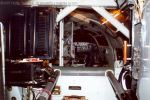
|
Leading forward is a crawlway over the rear wingspar into the flightdeck. We made use of this to move forward (and I thought the Lancaster spar was hard to get over . . . ). The flight engineers position is on the starboard side between the wingspars facing aft. Its an amazing array of dials switches and levers. On the other side is a further array of equipment which one of the restoration team was working on.
The view forward from the galley, through the spar crawl-way.
|
|
The restoration team member was Herb Powell who was looking at part of the electrical system. I'm afraid I gave this gentleman a bit of a start, because although he had turned off the electrical master switch I managed to operate my flash just as he touched his screwdriver to a contact - resulting in a moments consternation - oops!
Herb at work - the view looking aft from the Navigator's position.
|
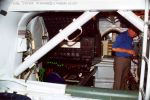
|
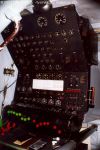
|
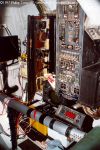
|
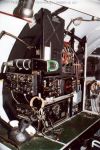
|
Far Left: Flight Engineer's Console
Centre: Electrical equipment
Right: Radio Officer's Position
|
The Flight crew was normally five officers - the Captain, First Officer, Navigation Officer, Radio Officer, and Flight Engineer. In TEAL crews, some of the First Officers held 1st Class Navigator's Tickets - making them Senior First Officers. SFO's sometimes flew as Navigation Officers - to keep up the hours to keep their Tickets current. John Van Duivenboden later told me that in addition the regular Flight crew and Stewards, on Pacific flights the aircraft also carried a Flight Clerk. This position involved dealing with all passenger travel documents, and smoothing out travel arrangements as the rules and conventions in force today were not as widely applicable in those days.
Moving forward (over the other spar), on the port side is the Navigator's table - and then the Radio Officer's position. Up front of course are the Captain's and First Officer's positions at the controls. The flight deck is amazingly roomy - on the starboard side are two rest positions for the crew to relax. For display purposes, one of the rest chairs has been removed, along with the First Officer's seat. On the starboard where the crew access would normally be, a perspex panel has been installed in place of the crew's hatch. This allows visitor viewing from an external platform into the flight deck. The removal of the First Officer's seat also makes access to the control panel very easy.
The pictures above show some of the equipment on the Flight Deck. The first picture is looking forward from the spar along the port side. The ladder leads to the astrodome, and is next to the Navigator's table. The gentlemen are shown working on some of the Radio equipment at the Radio Officers position. A closeup of this equipment is above. Further forward the control panel can be seen . The next picture shows the Navigator's table with some of its equipment. The third picture is looking up and aft at the astrodome. The controls seen in black are the Flight Engineer's startup panel. The red objects to the right of the panel are the release toggles for the inflatable emergency dinghys, which are stored in the top of the hull.
|
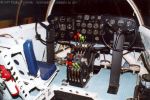
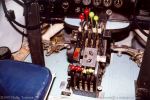
Up close with the controls - these images show the general layout,
the central quadrant, and the roof mounted equipment.
|
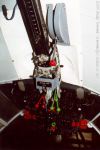
|
|
Ed and I spent some time on the flight deck pointed out a number of the items of equipment to me while we discussed our common Cornish heritage. While we were talking, an Irishman (who had crewed on wartime flying boats) was shown round by Hugh Yates - who clearly enjoys this task! Hugh also told me quite a lot about the Solent. Then it was time to exit the aircraft which we did via the crew hatch on the starboard side. Ed Tredrea and I then went off to view some of the TEAL memorabilia displayed in cases near the aircraft
|
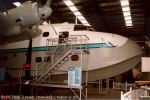
|
I'd like to take this opportunity to thank the Solent team for their friendly welcome and the effort they went to in showing me around. Thanks Folks!
Technical Data
- Accommodation : 8-9 crew & 45 passengers
- Dimensions
- Span : 34.5m (112'0ft)
- Length : 27.4m (89'8ft)
- Height : 11.4m (37'3ft)
- Weight
- empty : 22,217kg (48,900lb)
- max : 36,742kg (81,000lb)
- Power Plant : 4x 2040hp Bristol Hercules 733
- Performance :
- max speed : 444km/h (276mph)
- max climb : ft/min (m/min)
- ceiling : 17000ft (5180m)
- range : 3745km (2330miles)
Images - Close Up
Since the area in which this aircraft is displayed is somewhat crowded, it is difficult to get a single picture of the 'whole' aircraft. This being the case, I think all these pictures fit into the 'close-up' category. (Remember to let me know if you have a request for an image of a particular part of the aircraft!).
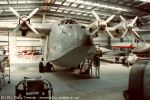
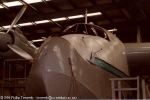
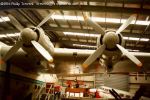
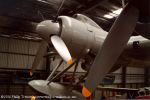
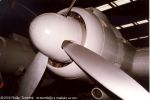
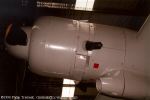
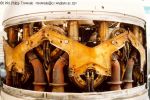
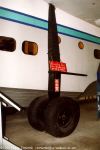
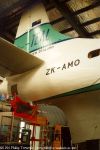
 © 1996-98 Phillip Treweek, all rights reserved
© 1996-98 Phillip Treweek, all rights reserved